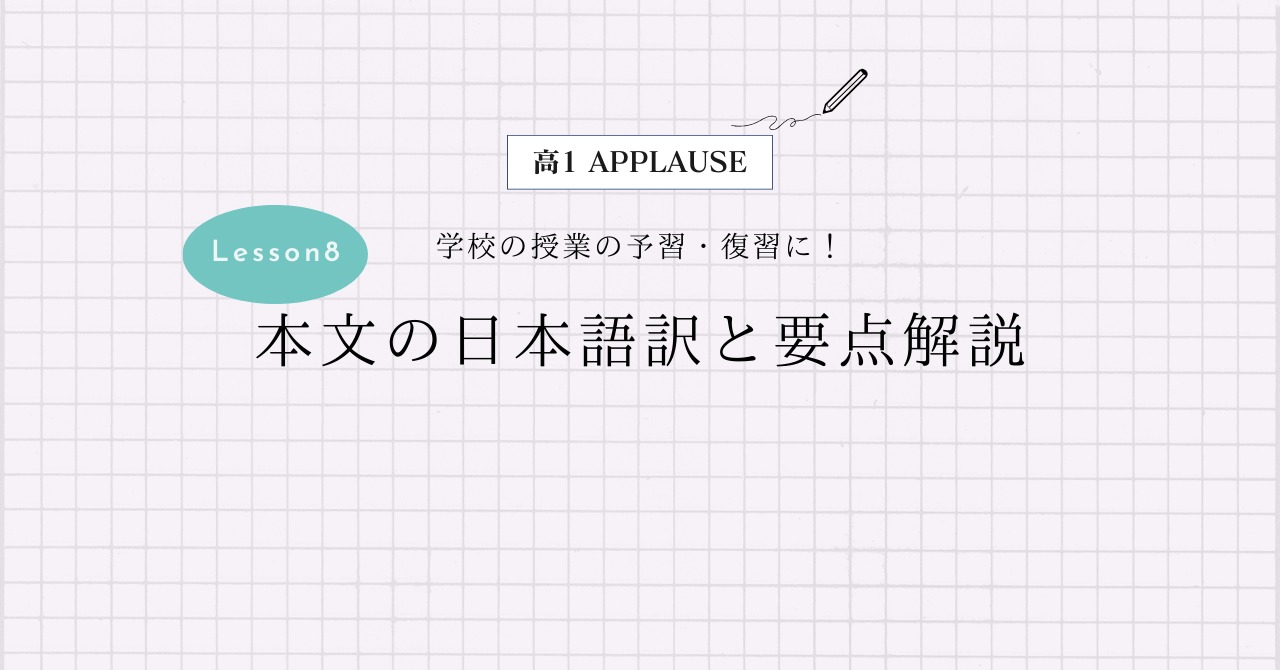開隆堂 高1APPLAUSE Lesson10 Section2の本文の日本語訳と重要箇所の解説です。
Lesson10-1, 10-3, 10-4の解説はこちらからご覧ください。
>高1APPLAUSE Lesson10 Section1 本文和訳
>高1APPLAUSE Lesson10 Section3 本文和訳
>高1APPLAUSE Lesson10 Section4 本文和訳
- APPLAUSE Lesson10 Section2 本文と日本語訳
- APPLAUSE Lesson10 Section2 重要事項の解説
- In the aftermath of the Great Hanshin Earthquake, in Hanshin and Awaji, the water supply was stopped.
- Oda Kanetoshi waited in a long line in front of water trucks, then he saw the water in a pond nearby and thought, “I wish I could drink the pond water.”
- Then he remembered one sentence of a thesis, “Poly-glutamic acid has the potential quality to purify water, and it’s found in natto.”
- This statement lit Oda’s soul.
- After many trials and errors for several years, it was a water-purifying powder that he finally succeeded in developing.
- When you put one spoonful of water-purifying powder in water full of green algae, they coagulate in a flash.
- It precipitates to the bottom, and clean water is left.
- This purified water is good to drink.
- APPLAUSE Lesson10 Section2 まとめ
APPLAUSE Lesson10 Section2 本文と日本語訳
In the aftermath of the Great Hanshin Earthquake, in Hanshin and Awaji, the water supply was stopped.
「阪神淡路大震災の直後に、水の供給が止められました。」
Oda Kanetoshi waited in a long line in front of water trucks, then he saw the water in a pond nearby and thought, “I wish I could drink the pond water.”
「小田兼利さんは給水車の前の長い列で待っていて、そのときすぐ近くにある池の水を見て、『池の水を飲めたらなあ。』と思いました。」
Then he remembered one sentence of a thesis, “Poly-glutamic acid has the potential quality to purify water, and it’s found in natto.”
「それから彼は『ポリグルタミン酸は水を浄化する性質をもつ可能性があり、それは納豆で発見されている。』という、ある論文の1文を思い出しました。」
This statement lit Oda’s soul.
「この文は小田さんの心を明るくしました。」
After many trials and errors for several years, it was a water-purifying powder that he finally succeeded in developing.
「数年間のたくさんの試行錯誤の後、水を浄化する粉を、彼はついに開発することに成功しました。」
When you put one spoonful of water-purifying powder in water full of green algae, they coagulate in a flash.
「スプーン1杯の水を浄化する粉を緑の藻でいっぱいの水に入れると、藻が瞬く間に凝固します。」
It precipitates to the bottom, and clean water is left.
「それは底に沈殿して、きれいな水が残ります。」
This purified water is good to drink.
「この浄化された水は飲むのに適しています。」

APPLAUSE Lesson10 Section2 重要事項の解説
In the aftermath of the Great Hanshin Earthquake, in Hanshin and Awaji, the water supply was stopped.
“aftermath”は「(災害などの)直後、後遺症」といった名詞で、“in the aftermath of~”は「~の直後に」といった意味になります。
“supply”は「供給」という名詞で、ここでは「受動態」になっていますね。
Oda Kanetoshi waited in a long line in front of water trucks, then he saw the water in a pond nearby and thought, “I wish I could drink the pond water.”
“wait”は「待つ」という動詞で、“line”は「列、線」、“water truck”は「給水車」という名詞になります。
“in front of~”は「~の前に」という重要表現ですね。
“then”は「それから,そのとき,それでは」といった意味の副詞です。文に応じて柔軟に訳してあげてください。
“pond”は「池」という名詞、“nearby”は「すぐ近くに」という副詞です。
最後の発言内容では、「I wish 仮定法」が使われていますね。
Then he remembered one sentence of a thesis, “Poly-glutamic acid has the potential quality to purify water, and it’s found in natto.”
“remember”は「を思い出す、覚えている」という動詞で、“sentence”は「文」、“thesis”は「論文」という名詞です。
“of”は前置詞で,”A of B”の形で「BのA」というように後ろから前に訳します。
“Poly-glutamic acid”は「ポリグルタミン酸」、“quality”は「質、性質」という名詞で、“potential”は「可能性のある、見込みのある」という形容詞、“purify”は「を浄化する、きれいにする」という動詞になります。
“to purify”は「不定詞の形容詞的用法」で、直前の“the potential quality”を修飾しています。
“found”は“find(を見つける、発見する)”の過去分詞形で、ここでは「受動態」になっていますね。
“it”は直前の文の内容を指しています。
This statement lit Oda’s soul.
“statement”は「声明、意見、文」といった名詞です。
“lit”は“light(を明るくする)”の過去形で、“soul”は「魂。心」といった名詞ですね。
名詞に‘sを付けると「~の」という所有を表します。
直前の名詞が複数形のときは” teachers‘ “のようにアポストロフィーだけを最後に付けます。
After many trials and errors for several years, it was a water-purifying powder that he finally succeeded in developing.
“after”は「~の後で」という前置詞で、“trial and error”は「試行錯誤」という表現になります。
“several”は「いくつかの」といった形容詞で、“for 時間”で「~間」という意味ですね。
“it was a water-purifying powder that”は「強調構文」になっています。
「強調構文」とは、強調したい箇所を”it is(was)”と”that”で挟んであげます。”that”は省略することもできます。
訳すときは、まず強調しないふつうの文章の語順を考えてあげましょう。そのうえで、強調する箇所をわかりやすく訳してあげればOKです。
今回でいうと、“he finally succeeded in developing a water-purifying powder”が本来の語順になります。
“finally”は「ついに、最終的に」という副詞、“water-purifying powder”は「水を浄化する粉」という名詞、“succeed in~”は「~に成功する」、“develop”は「を開発する、発展させる」という動詞です。
“in”は前置詞なので、“developing”は「動名詞」になっていますね。
When you put one spoonful of water-purifying powder in water full of green algae, they coagulate in a flash.
この文では「接続詞when」が使われています。
“put A into B”は「AをBに入れる」、“one(a) spoonful of~”は「スプーン1杯の~」という意味になります。
“full of~”は「~でいっぱいの」という意味、“algae”は“alga”の複数形で「藻」という名詞です。
“full of~”のように2語以上の形容詞句の場合は、ふつう名詞の後ろに置いて修飾します(後置修飾)。
“they”は“green algae”を指しています。
“coagulate”は「凝固する」という動詞で、“in a flash”は「瞬く間に」という表現です。
It precipitates to the bottom, and clean water is left.
“It”は「凝固したかたまり」を指していると思います。
“precipitate”は「沈殿する、凝結して降下する」という動詞で、“bottom”は「底」という名詞です。
“left”は“leave(を離れる、を残す)”の過去分詞形で、ここでは「受動態」になっていますね。
This purified water is good to drink.
“purified”は「過去分詞」として、“water”を修飾していますね。
“be good to 動詞の原形”は「~するのに良い」という意味になります。
今回は「適している」と訳しました。
APPLAUSE Lesson10 Section2 まとめ
以上がAPPLAUSE Lesson10 Section2の日本語訳となります。
「強調構文」「分詞」などの文の作り方を確認しておきましょう!
>高1APPLAUSE Lesson10 Section1 本文和訳
>高1APPLAUSE Lesson10 Section3 本文和訳
>高1APPLAUSE Lesson10 Section4 本文和訳
何か分からない点や他に解説してほしい点があれば,お気軽にコメントしてください!



コメント